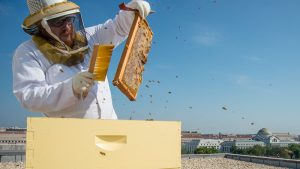
Bee-harvesting in an urban setting. Preparations are underway for the 16th Biodiversity Convention of the Parties (COP16) in Cali, Valle del Cauca. Credit: USDA
By Stella Paul
HYDERABAD & MONTREAL, May 2 2024 – In a world faced with habitat loss and species extinction, climate change, and pollution, it’s crucial that countries develop their national action plans and create a society that lives in harmony with nature, says David Cooper, Acting Executive Secretary of the UN Convention on Biological Diversity (CBD), in an exclusive interview with IPS.
And in a year where more than 4 billion people across the globe are expected to participate in elections, Cooper believes that politicians should put biodiversity on their manifestos.
Since taking the reins from the previous Executive Director, Elizabeth Mrema, Cooper has been at the forefront of steering the CBD towards the implementation of the Global Biodiversity Framework.
Later this year, world leaders will gather in Cali, Colombia for the 16th Biodiversity Convention of the Parties (COP16) slated for October 21 to November 1, 2024 for which preparations are currently underway.
Cooper gives insight into the core issues that will be on the top of the COP16 agenda, the current status of biodiversity finance, including the newly operationalized biodiversity fund, the upcoming meetings of the scientific and technical bodies of the CBD, the current status of National Biodiversity Strategies and Action Plans (NBSAP) and what is likely to unfold in the coming months in Digital Sequence Information (DSI).

David Cooper, Acting Executive Secretary of the UN Convention on Biological Diversity (CBD).
Biodiversity Finance: On Track but at Slow Pace
The UN Biodiversity Convention aims to mobilize at least USD 20 billion per year by 2025 and at least USD 30 billion per year by 2030 for biodiversity-related funding from all sources, including the public and private sectors.
However, the current situation with biodiversity funding shows that while progress is happening, it’s not fast enough. Some countries and groups are trying hard to give more money to projects that help nature, but overall, it’s still below expectations, and there are unfilled promises, Cooper acknowledges.
“We need to see a serious road map,” Cooper says, “All countries, in particular the donor country community, have to see how we are going to achieve at least that USD 20 billion by 2025 because that’s imminent.”
He called on big donors to honor their commitments.
“It’s really important that the big donors who promise money actually follow through and give the money they said they would. We need everyone to work together to make sure there’s enough money to protect our plants, animals, and the places they live,” Cooper says. “Certainly, we need to see all countries put efforts behind all of the goals and targets of the framework and that, of course, includes those on financial resources.”
Cooper welcomed the decision by the Global Environment Facility (GEF) to establish a new fund, the Global Biodiversity Framework Fund. He said the CBD secretariat was working closely with Carlos Manuel Rodriguez, the GEF CEO, and his team.
“We then saw a number of contributions to that fund coming. The contribution from Canada is a significant one of 200 million Canadian dollars. Other significant donations came from Germany, Spain, Japan, and most recently, Luxembourg. Actually, the contribution from Luxembourg, if we look at its pro rata, given the size of the Luxembourg economy, is also quite generous, even though it’s only USD 7 million in total.”
National Biodiversity Strategies and Action Plans (NBSAPs)
It’s not only about funding, Cooper says, but countries showing their commitment to their agreements, including developing NBSAPs. He acknowledged that very few countries had submitted so far.
“It’s only a few countries so far, and Spain, Japan, China, France, Hungary, and Ireland have submitted their NBSAPS, as well as the European Union,” says Cooper.
While he is optimistic that all the countries will develop their targets, he recognizes that it’s a complex process.
“I think most countries are in the process of developing their national targets, which is the first thing they’re supposed to do. But this is a process that is also supposed to engage all the different sectors of the economy and all the different parts of society, with the engagement of local communities, indigenous peoples, businesses, and so on.”
The CBD supports the countries through the complexities.
“The developing countries in particular have been supported through the Global Environment Facility. We’ve also been organizing a number of regional dialogues so that countries can share their experience as they move forward,” Cooper says.
At COP15, it was decided that all countries should submit their NBSAPs, if possible, before COP16.
“If they’re not able to submit their full NBSAPS by then, then at least they should provide their updated national targets. So, we do expect many, many countries to have progressed on their NBSAPs by COP16. Immediately prior to COP16, there will be another meeting of the subsidiary body on implementation to also take stock of where we are on that.”
COP16: What’s In, What’s Out
The core focus of CBD COP16 is likely to revolve around the adoption and implementation of the Post-2020 Global Biodiversity Framework. This framework sets out the global targets and goals for biodiversity conservation and sustainable use for the next decade and beyond. Key aspects of the framework may include targets related to halting biodiversity loss, promoting sustainable resource management, enhancing ecosystem resilience, and ensuring equitable sharing of the benefits derived from biodiversity.
“I think I can highlight four key areas for COP 16,” says Cooper. “The first is that we have to see, and we have to have demonstrated progress in terms of implementation of the Global Biodiversity Framework. That means national targets are set. That means NBSAPs developed in at least a majority of countries. That means funds are flowing, which means, as I said before, a credible path towards this USD 20 billion by 2025 target. It also means the Global Biodiversity Framework Fund should be receiving more funds and supporting more projects.”
The second core issue will be the fair and equitable sharing of benefits from the use of Digital Sequence Information (DSI) on genetic resources. There was an agreement made at COP15 to establish this mechanism, but no details were fleshed out at that time, so those details are now being negotiated in an intergovernmental working group.
“Of course, the establishment of such a mechanism with a fund would give another major boost to the Convention because it would bring in another source of funding.”
The third area would be finance, he says.
“The fourth area that I would highlight is the need to further strengthen the role of indigenous peoples and local communities as key actors.”
He also points out that there’s a number of other issues, such as the issue of biodiversity and health and synthetic biology, that need to be managed, including looking at a risk assessment and risk management for, for instance, gene-edited mosquitoes.
“They’ve determined that the theme of the COP will be peace with nature, which is a broad theme that will include many, many issues,” he reveals.
Plastic Pollution Treaty and CBD’s Role
The fourth session of the Intergovernmental Negotiating Committee (INC-4) on plastic pollution in April 2024 at the Shaw Center in Ottawa, Canada, aims to develop an internationally legally binding instrument on plastic pollution, including in the marine environment, to end plastic pollution by 2040.
Ending plastic pollution is also one of the biodiversity targets, Cooper says, adding that the CBD is actively involved in the logistical organization of INC-4.
“Also, the reduction of waste from plastics and pollution from plastics is one of the elements of target 7 of the Kunming Montreal Global Biodiversity Framework. So, we are seeing the success of INC-4 negotiations as hugely important for the implementation of the Framework,” he says.
What to Watch out for Between Now and COP16
Although all eyes will be on the COP16 negotiations, there are a number of global events taking place in the next few months that will contribute to the agenda and determine the level of the world’s preparedness for the conference.
“The most important ones are obviously the SBSTTA (Subsidiary Body on Scientific, Technical, and Technological Advice) and the SBI (Subsidiary Body on Implementation), then this working group on Digital Sequence Information that will take place in August,” Cooper says.
Like the SBI, SBSTTA is a subsidiary body established under the CBD. While the SBI specifically assists in reviewing progress in the implementation of the Convention and identifies obstacles to its implementation, among other functions, SBSTTA plays a crucial role in ensuring that decisions made under the CBD are informed by the best available scientific evidence and technical expertise.
“Then we have the G7 and G20 processes coming up, which are important processes to show leadership. The CBD COP itself will be followed by the COPs of climate change and desertification, making the linkage between these. Also, we expect Colombia and the indigenous peoples will host just before COP, a pre-cop focusing on indigenous peoples and local communities and their roles,” Cooper says.
Finally, as a record 64 countries across the world hold their elections this year to elect a new national government, does this provide a unique opportunity to speak about biodiversity and should biodiversity, like climate change, be made an election issue?
“Definitely,” says Cooper.
“If we look at many of the extreme events that people suffered from, particularly last year, whether these be fires, wildfires, droughts, storms, or floods, you know, these are largely attributed by the media to climate change. Climate change is increasing the probability and severity of these events, but these events are also happening because of ecosystem degradation because we haven’t been managing biodiversity and ecosystems well. So, I think we all have an opportunity to make this message and these links clearer. Politicians have a particular responsibility to do so, and I hope more of them will do so as these various elections in various parts of the world pan out.”
IPS UN Bureau Report